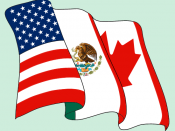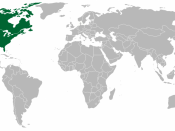Has NAFTA helped or hurt the United States?
The North American Free Trade Agreement (NAFTA) is a very significant aspect of international trading in North America, whose three nations include the U.S., Canada, and Mexico, as well as being a large step in the growth of the economic policy of the United States. The ideas behind NAFTA are based on the fact that due to the technological advances in computers and communications, no one nation can separately compete on the foreign market. NAFTA was designed to improve trade between the North American countries by removing tariffs on the exportation of international goods, as well as weakening borders between the nations. "A world of free trade is far more likely to be prosperous (and peaceful) than a world of tariffs and borders" (Hufbauer 31).
NAFTA went into effect in 1994, but originated from the Canada-U.S. Free Trade Agreement of 1989, with which the trade barriers between the United States and Canada were eliminated.
This was a logical agreement because as well as the U.S., Canada was also a highly developed country whose average income and hourly wages are equivalent to the U.S., therefore making the two countries very similar and have many things in common. A few years after the Canada-U.S. Free Trade agreement came into effect, Mexico wanted in on the treaty, leading to The North American Free Trade Agreement, which was ratified and came into effect on January 1, 1994. The objectives of NAFTA, as stated in the actual document, are listed below:
"Article 102: Objectives
1. The objectives of this Agreement, as elaborated more specifically through its principles and rules, including national treatment, most-favored-nation treatment and transparency, are to:
a) eliminate barriers to trade in, and facilitate the cross-border movement of, goods and services between the territories of...


